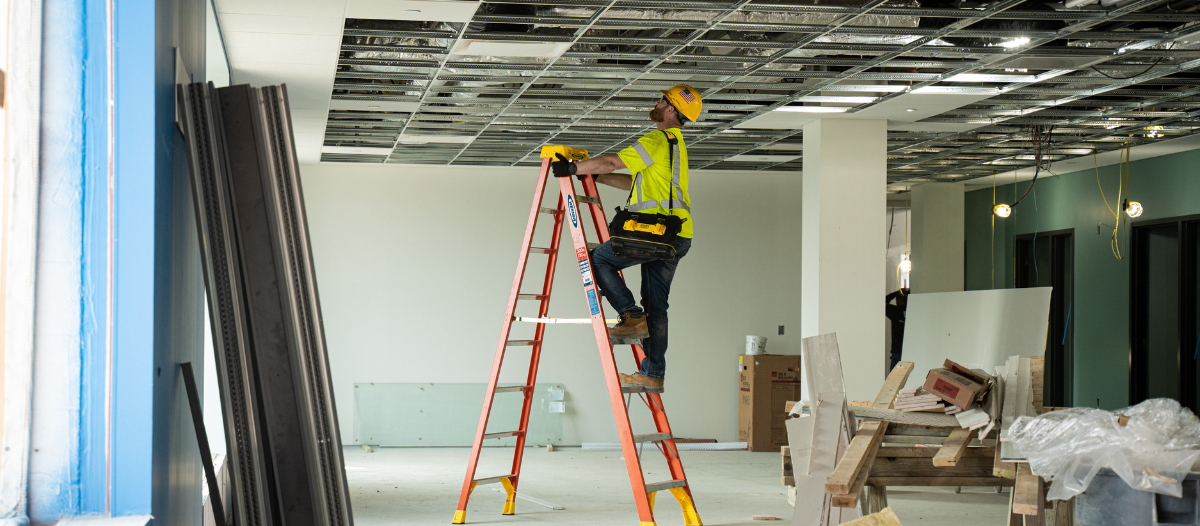A Step Up
What FM teams should know about ladders

Ladder manufacturers make safe ladders, but users make ladders safe. Quality ladders are engineered and manufactured under robust ANSI A14 safety standards. Ladders undergo dozens of tests before reaching the public. But even the safest ladder is no match for someone who misuses it.
In contrast, some power saws are now being outfitted with sensors that automatically shut down if they come in contact with human skin. Unlike in the power tool industry, there is no analogous technology to prevent improper ladder use. Ladder makers must rely on ladder users to follow the warnings and instructions. The simple truth is that most ladder-related accidents happen because the person using it did something they were not supposed to do.
If a user overreaches while on a ladder, leans to one side, sets up the extension ladder at a too-shallow angle or does not extend three feet of ladder above a roofline for elevated access, no sensor or alarm will alert or prevent them from doing so.
Human beings can function on autopilot, and people who use ladders repeatedly can become complacent.
It is important for ladder users to be attentive to their work, to pause a moment and think every time they get ready to use it – to be mindful and not hurry. They should go through the appropriate steps for safe ladder usage, taking each step seriously.
 Choosing the ladder
Choosing the ladder
Ladder safety begins with choosing the right ladder for the job. There are different types of materials, with fiberglass and metal/aluminum being most common. Wood ladders still exist, but no new ones have been made for several years. There are different ladder styles to consider – extension, articulated, stepladder, combination – and five categories of ladder duty ratings. These ratings start at light duty (Type III) with a 200-pound capacity and go up to extra heavy duty (Type IAA) at 375 pounds.
Users should consider the following questions before choosing a ladder:
-
Is the work near electrical sources? If so, metal/aluminum ladders should not be used.
-
What is the working height? Ensure time is not wasted by arriving on site with a ladder that is too short or too long.
-
Will the ladder be resting on an uneven surface? If so, a leveler accessory will be needed.
-
Will the work area be crowded with people and/or materials? If there are obstructions in the path of the climb, a ladder may not be a good option.
Pre-use inspection & proper setup
A pre-use inspection must be conducted every time, with no exceptions. It is dangerous to rely on the ladder's good working order when last used. If it was not securely tied down during transport to a job site, it may have sustained damage. A pre-use inspection will reveal impairments. A ladder left at the job site for several days or weeks could have been repositioned, compromising its original placement. The feet of the ladder may no longer be evenly supported, it might be sinking into soft soil or the angle might have changed.
All feet of the ladder must be on a level, solid, flat surface. For extension ladders, use the correct set-up angle. The user should be able to stand with their toes at the bottom or base section, extend their arms straight out at shoulder height and grasp the ladder side rails with their palms. If they cannot reach the side rails, the angle is too shallow, and they are at risk of the ladder feet sliding out and away as they climb up. Also, for extension ladders, there should be at least three feet of ladder extending above the roof line when accessing the roof.
For step ladders, be sure not to stand on the top step or top cap. Those upper surfaces are not meant for climbing. Those surfaces will add to the user’s stability when they brace into the ladder structure with their legs while standing and working.
Users can always have someone hold the ladder or tie it off to a secure object for added stability. In fact, OSHA requires it when accessing a roof. Other safety accessories are available, too, like levelers to extend one foot to account for a sloping surface and shoe spikes to help prevent ladder feet from sliding on soft or slippery surfaces.
Safe climbing
Users should always maintain three points of contact – two feet and one hand or two hands and one foot –. Climb slowly and deliberately and avoid sudden movements. The center of their stomach or belt buckle should always be between the side rails when climbing (and while working). Never overreach or lean while working. This can cause falls or tip the ladder sideways. Never attempt to move a ladder while standing on it. Use towlines, a tool belt or an assistant to handle materials so that both hands remain free during the climb.
Safety training
The ladder industry invests heavily in safety training. The website laddersafetytraining.org is a completely free resource filled with safety content: videos, tip sheets and archived seminars. It is designed to seamlessly integrate into corporate safety training courses. Home ladder users can access it, too.
Some people joke about all the safety labels on ladders, but consider this: ladders tell users exactly how to use them on these labels – the user’s manual is attached directly to the tool.

Mike Van Bree is the director of product safety and engineering at Louisville Ladder Inc. and is the President of the American Ladder Institute (ALI), the industry trade association. He has years of mechanical engineering experience in a variety of industries and with a broad scope of products. His expertise includes climbing equipment and support structures. Van Bree specializes in product design, manufacture, warnings, testing, safety analysis, incident investigation, failure analysis and human interaction with climbing products. He has developed and designed product warnings and instruction manuals and tested products for compliance with ANSI and OSHA standards. He is a hands-on engineer with program management experience in research, development, production and marketing of mass-merchandised products. Van Bree has performed hundreds of incident investigations, including product and site inspections, human factors and ergonomics evaluations, mechanical and failure analyses, product testing and accident reconstruction. He has provided expert consulting in matters pending in state and federal jurisdictions across the country regarding product design, product safety, root cause analysis, accident reconstruction and product recalls.
Read more on Risk Management , Performance & Quality and Operations & Maintenance or related topics Occupant Safety , Regulations and Risk Management
Explore All FMJ Topics









